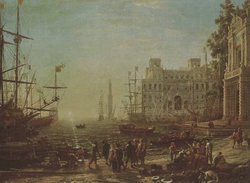Port
|
|
- For other uses, see Port (disambiguation).
A port is a facility at the edge of an ocean, river, or lake for receiving ships and transferring cargo and persons to them. Ports have specially-designed equipment to help in the loading and unloading of these vessels. Cranes and refrigerated storage may be provided by private interests or public bodies. Often, canneries or other processing facilities will be located very close by.
The term seaport is used for ports that handle ocean-going vessels, and river port is used for facilities that handle river traffic. Sometimes a port on a lake or river also has access to the ocean, and is then referred to as an inland port. A fishing port is a type of port or harbor facility particularly suitable for landing and distributing fish. While the term airport is derived from port, such places are never referred to as ports.
Critical to the functioning of seaports and river ports are:
- Presence of deep water channels (40 feet or 12 meters minimum) and berths
- Protection from wind, wave, and surge
- Access to intermodal transportation (trains and trucks)
Typical equipment used at a container seaport includes:
- Berth Gantry - large berth side craned used for the loading and unloading of vessels.
- Yard Gantry - smaller gantries found throughout the container yards. Can be Rail Mounted Gantry (RMG) or Rubber Tired Gantry (RTG).
- Trucks - used to carry containers between Gantries with use of attached chassis. Also called "bomb carts" or "Ottawas"
- Stratle Carriers - used in place of Trucks, this purpose built vehicle "straddles" a container and moves it to its destination.
- Top Picks - Used to move empty containers. Grabs containers from the top.
- Racks - Used to move empty containers. Grabs containers from the side.
Containerized cargo allows for quicker transport and distribution as individual products, boxes or bulk cargo need not be "debussled" or paletized at each transportation point. Cargo can be sealed at point of origin, transported via intermodal, stacked and loaded on purpose ships, and ultimately opened at final point of resale or destination. This is a vital part of modern retailing "Just in Time Delivery" strategies.
Standard Containers are measured in Twenty-foot Equivalent Units (TEUs). Standard container sizes are 20', 40', and 45' units. Heights are either 8.5' or 9.5'. Standard containers may weight up to 50,000 pounds.
Seaports and river ports are often equipped with large cranes for the loading and unloading of containers from container ships. These are usually operated by stevedores. Pilots and tugboats are also used to safely maneuver the ships in tight quarters.
Major ports
Port_of_Wellington_at_night.jpg
World Port Rankings (volume in millions of TEUs)(2004):
- Port of Hong Kong China | 21.9
- Port of Singapore Singapore| 20.6
- Port of Shanghai China | 14.6
- Port of Shenzhen China | 13.7
- Port of Pusan South Korea | 11.3
- Port of Kaohsiung Taiwan | 9.7
- Port of Rotterdam Netherlands | 8.3
- Port of Los Angeles USA | 7.3
- Port of Hamburg Germany | 7.0
- Port of Dubai United Arab Emirates | 6.4
- Port of Antwerp Belgium | 6.0
- Port of Long Beach USA | 5.8
- Port Klang Malaysia | 5.2
- Port of Qingdao China | 5.1
- Port of New York/New Jersey USA | 4.4
Source: Port of Klang website world port ranking (http://www.westportmalaysia.com.my/06_statistics.htm)
See also
External links
- Port rankings from the AAPA (http://www.aapa-ports.org/industryinfo/statistics.htm)
- World Port Rankings 2002, by metric tons and by TEUs, American Association of Port Authorities (http://www.aapa-ports.org/pdf/WORLD_PORT_RANKINGS_2002.xls) (xls format, 26.5kb)da:Havn

